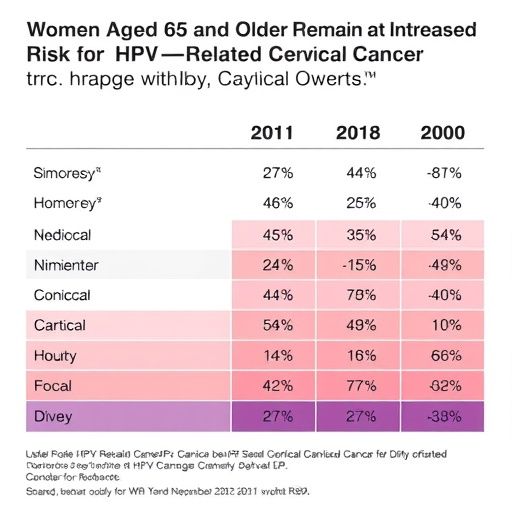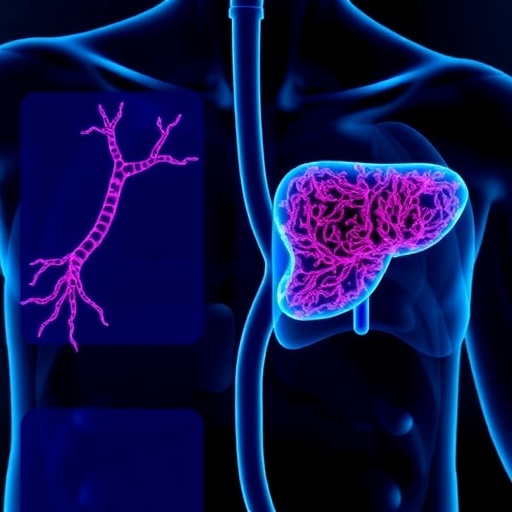
Emerging research from a comprehensive observational study published in Gynecology and Obstetrics Clinical Medicine has shed new light on the ongoing risks of cervical cancer among women aged 65 and older, emphasizing the urgent need for renewed screening initiatives in this demographic. Despite prevailing medical guidelines advising the cessation of cervical cancer screening past the age of 65 in women with no prior abnormalities, the study challenges this paradigm, highlighting a persistently elevated incidence of high-risk human papillomavirus (HPV) infections and cervical intraepithelial neoplasia grade 2 or worse (CIN2+) within this age group.
This large-scale analysis utilized an unprecedented dataset collected from more than two million women — precisely 2,152,766 — across a diverse array of 628 medical institutions throughout Shenzhen, China, spanning six years from 2017 to 2023. By examining such a massive population sample, the researchers were able to scrutinize patterns of HPV genotype distribution, infection multiplicity, and associated cervical pathology, with a special focus on those aged 65 and above. The study cohort had a mean age of 40 years, predominantly ranging from 25 to 54 years old, with the subset aged 65 or older constituting just under 1% of the total.
Key findings revealed that older women are disproportionately affected by high-risk HPV types and exhibit a higher prevalence of significant cervical abnormalities. Approximately 14% of women aged 65+ tested positive for high-risk HPV strains compared to 8% in younger women. Furthermore, older women demonstrated increased instances of multiple HPV infections—both double and triple infections were notably more common. This multiplicity correspondingly correlated with a heightened risk of CIN2+, indicating a compounding effect on carcinogenic potential as the number of concurrent infections increased.
.adsslot_d4wjWa57FI{width:728px !important;height:90px !important;}
@media(max-width:1199px){ .adsslot_d4wjWa57FI{width:468px !important;height:60px !important;}
}
@media(max-width:767px){ .adsslot_d4wjWa57FI{width:320px !important;height:50px !important;}
}
ADVERTISEMENT
The distribution of HPV genotypes in the elderly cohort presented notable distinctions compared to their younger counterparts. The most frequent high-risk types in women aged over 65 included HPV52, HPV16, HPV58, HPV56, and HPV68. Crucially, genotypes such as HPV18, HPV16, and HPV33 were predominantly associated with CIN2+ lesions, often in the context of concomitant double infections involving HPV52/58, HPV16/52, and HPV52/56. Such complex co-infections underline the sophisticated viral interplay potentially driving progressive neoplastic changes in cervical epithelia, emphasizing why screening discontinuation in this population might incur under-recognition of malignant progression risks.
The pathophysiological mechanisms underlying the augmented vulnerability of older women to persistent HPV infection and neoplasia remain a subject of active inquiry. Age-related immunosenescence coupled with estrogen deprivation post-menopause may attenuate the mucosal immune defenses crucial for HPV clearance. This immune decline, alongside hormonal shifts that alter the cervical microenvironment, could facilitate viral persistence and oncogenic transformation. Therefore, chronological aging does not equate to diminished oncogenic risk; instead, it could manifest as an augmented susceptibility due to biological and immunological shifts.
Despite the substantial sample size, the study acknowledged certain limitations: its retrospective nature, restriction to a single geographical region in China, and potential sampling bias given that women aged 65+ are not systematically included in China’s national cervical cancer screening programs. HPV vaccination rates were also notably low across the cohort, with just over 2% vaccinated, reflecting ongoing challenges in vaccine outreach and uptake, especially among older adults who missed the prime window of prophylactic immunization during their youth.
The implications of these findings extend to global health policy and clinical practice. International guidelines currently recommend discontinuing cervical cancer screening after 65 years of age provided the individual has a history of adequate negative screening and no high-risk factors. However, this recommendation predominantly stems from data in populations with established, widespread screening programs and vaccination coverage, conditions not universally met. The Shenzhen study’s demonstration of persistent and possibly escalating risk in older women, who may not have benefited from prior comprehensive screening or vaccination, calls these guidelines into question.
Moreover, as global life expectancy increases, women are living longer post-menopause, extending the window during which latent or newly acquired HPV infections may reside undetected and potentially progress. This demographic shift necessitates a re-evaluation of screening paradigms that currently exclude older women, particularly in regions where historical vaccination programs were absent or recently introduced. The study advocates for tailored screening protocols addressing the unique risk patterns of older women to mitigate cervical cancer morbidity and mortality effectively.
Practically, the study confirms that high-risk HPV infections, especially multi-genotype infections, heighten the probability of CIN2+ lesions, with detection rates significantly greater in women above 65—14% compared to 9% in younger counterparts. Notably, the detection rates of cervical cancer itself, although low in absolute numbers (16 cases in the older cohort versus 205 in younger women), suggest non-negligible incidence that warrants preventive intervention rather than screening cessation.
In conclusion, this groundbreaking observational study disrupts previously accepted norms concerning cervical cancer screening age thresholds. It underscores the complexity of HPV-related cervical oncogenesis in the elderly female population and advocates urgent reconsideration of current clinical guidelines to incorporate continued vigilance for women aged 65 and above. Such a shift could prove lifesaving, particularly amid rising global cervical cancer incidence and mortality in older women, as documented by the World Health Organization’s 2022 statistics indicating over 157,000 new cases and 124,000 deaths in this age group globally.
As our understanding of HPV’s role in cervical carcinogenesis deepens, and as immunological and hormonal factors in later life become better elucidated, healthcare systems worldwide may need to adapt screening frameworks. This will involve balancing resource allocation with evolving epidemiological realities to protect women’s health beyond traditional screening cut-offs. Ultimately, integrating scientific insights from expansive studies such as this will be critical to refining global cervical cancer control strategies in the 21st century.
Subject of Research: People
Article Title: High-risk HPV distribution and importance of continuing cervical cancer screening of women aged 65 years and older: a study based on 2 152 766 women in China
News Publication Date: 1-Jul-2025
Web References: http://dx.doi.org/10.1136/gocm-2025-000238
Keywords: Cervical cancer, high-risk HPV, HPV genotype distribution, screening guidelines, older women, cervical intraepithelial neoplasia, CIN2+, immunosenescence, postmenopausal hormonal changes, HPV co-infection, observational study
Tags: cervical cancer prevention strategiescervical cancer risk in older womencervical cancer screening guidelinescervical intraepithelial neoplasia in older adultshealth disparities in older womenhigh-risk HPV in women aged 65+HPV genotype distribution in elderlyHPV infection rates in seniorsmedical guidelines for HPV screeningneed for cervical cancer screening in seniorsobservational study on cervical cancerwomen’s health after age 65





